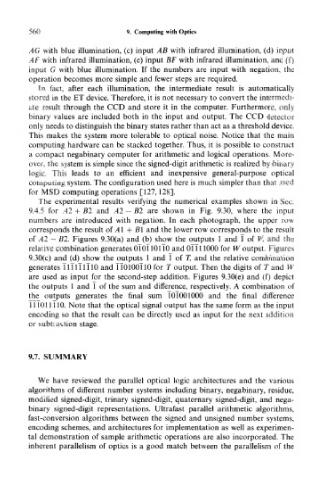Page 575 - Introduction to Information Optics
P. 575
560 9. Computing with Optics
AG with blue illumination, (c) input AB with infrared illumination, (d) input
AF with infrared illumination, (e) input BF with infrared illumination, and (!)
input G with blue illumination. If the numbers are input with negation, the
operation becomes more simple and fewer steps are required.
In fact, after each illumination, the intermediate result is automatically
stored in the ET device. Therefore, it is not necessary to convert the intermedi-
ate result through the CCD and store it in the computer. Furthermore, only
binary values are included both in the input and output. The CCD detector
only needs to distinguish the binary states rather than act as a threshold device.
This makes the system more tolerable to optical noise. Notice that the main
computing hardware can be stacked together. Thus, it is possible to construct
a compact negabinary computer for arithmetic and logical operations. More-
over, the system is simple since the signed-digit arithmetic is realized by binary
logic. This leads to an efficient and inexpensive general-purpose optical
computing system. The configuration used here is much simpler than that used
for MSD computing operations [127,128].
The experimental results verifying the numerical examples shown in Sec.
9.4.5 for A2 + B2 and A2 — B2 are shown in Fig. 9.30, where the input
numbers are introduced with negation. In each photograph, the upper row
corresponds the result of A\ + Bl and the lower row corresponds to the result
of A2 — B2. Figures 9.30(a) and (b) show the outputs 1 and 1 of W, and the
relative combination generates OlOllOllO and OlTllOOO for W output. Figures
9.30(c) and (d) show the outputs 1 and T of T, and the relative combination
generates Tl Till 110 and TIOlOOllO for T output. Then the digits of T and W
are used as input for the second-step addition. Figures 9.30(e) and (f) depict
the outputs 1 and T of the sum and difference, respectively. A combination of
the outputs generates the final sum ToTOOlOOO and the final difference
ITTOllTlO. Note that the optical signal output has the same form as the input
encoding so that the result can be directly used as input for the next addition
or subtraction stage.
9.7, SUMMARY
We have reviewed the parallel optical logic architectures and the various
algorithms of different number systems including binary, negabinary, residue,
modified signed-digit, trinary signed-digit, quaternary signed-digit, and nega-
binary signed-digit representations. Ultrafast parallel arithmetic algorithms,
fast-conversion algorithms between the signed and unsigned number systems,
encoding schemes, and architectures for implementation as well as experimen-
tal demonstration of sample arithmetic operations are also incorporated. The
inherent parallelism of optics is a good match between the parallelism of the

